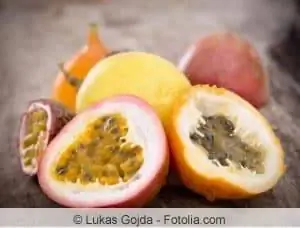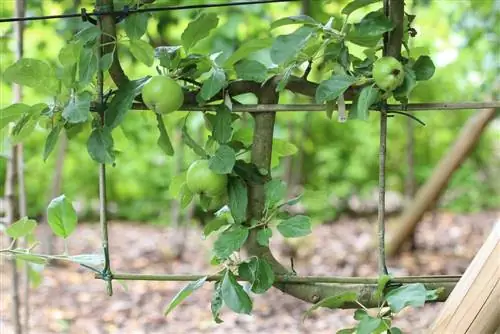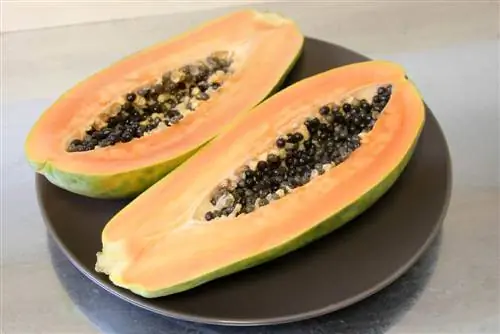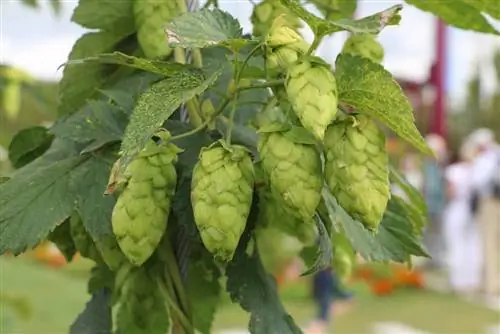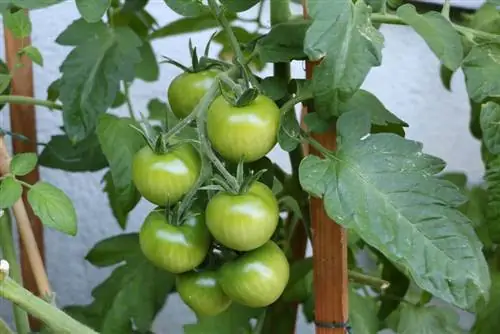- Author admin [email protected].
- Public 2023-12-17 03:39.
- Last modified 2025-01-24 12:45.
The passion fruit fruit was there first, but the passion fruit plant was discovered quite quickly by German indoor gardeners - actually not surprising, it is a beautiful climbing plant from the passion flower genus. Quick and easy to grow, wonderfully willing to grow, easy to care for, and you only need to visit the nearest supermarket to get seeds:
Growing a passion fruit plant
Passion fruit seeds are available to buy, but you can also get them directly from the passion fruit you bought from the fruit merchant:
- If you cut a passion fruit (yellow or purple, see below) in half, you will see the 3 - 5 mm large, dark seeds distributed throughout the pulp
- Spoon the pulp out of the fruit halves and separate the seeds
- If the pulp around the seeds remained, it would mold during the germination process
- You can separate the pulp and seeds by rubbing the mixture between two sheets of kitchen paper (use new paper several times)
- You can also eat the pulp in a rustic way, or suck it from the seeds, it's much quicker
- These seeds are also first rubbed off as best as possible with or in kitchen paper
- The remaining adhering components are removed by “washing” the seeds in fine dry sand (bird sand or similar): make washing movements with your hands in a bowl with sand and seeds
- The sand reliably removes the remaining pulp from the seeds and can be easily rinsed using a sieve with the correct mesh size
- If you don't want to sow the seed right away, it's easier:
- Spread a large terry towel on a table
- Separate the seeds from the pulp as much as possible when they are fresh and spread them flat in the middle of the towel
- Let it dry for a few days to weeks, turn the towel towards the bag
- Free seeds from pulp residue and dry seed coats by rubbing them
- Now you can sow in loose, nutrient-poor potting soil, e.g. B. in a mixture of coconut hum and perlite or sand.
- Dry seeds are soaked in lukewarm water for at least 24 hours
- Fill plant pots with only slightly moistened substrate, place seeds 1 cm apart and press down (do not cover)
- Cover the cultivation pots with a glass hood or clear plastic film, the increased humidity promotes germination
- Place in a warm and bright place with temperatures of 25 °C to a maximum of 30 °C
- The windowsill, even above the heating that is switched on, is often not warm enough
- Check the temperature with a thermometer; if in doubt, a heated indoor greenhouse can help (can be purchased from around 40 euros)
- Keep the substrate slightly moist, but not wet, it is best to water with a spray bottle
- The seeds need about 4 weeks to germinate under these conditions; if they are kept colder, it will take longer.
- If the seedlings are easy to grip with your fingers, one to three are planted in their own plant pot
- Planting distance at least 5 cm, same substrate as for cultivation
Further care of Passiflora edulis
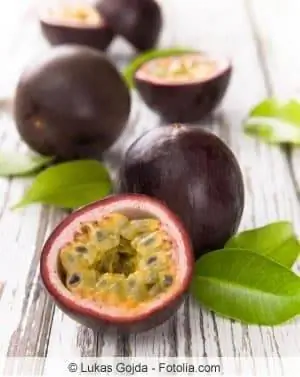
The young plants are placed in the brightest location you have to offer. After a short period of getting used to it, it can also lie in full sun all day long, which promotes flower development. During the growth period, the Passiflora edulis wants to be kept as warm as possible, preferably outdoors until shortly before the first night frosts. As a climbing plant, the passion fruit needs a lot of water; the substrate should always be slightly moist during the growth period. The passion fruit also doesn't like waterlogging because the roots then quickly begin to rot. If your water is very hard, let it stand well before watering and repot often. Water that is too hard or, as a result, a substrate that is too hard can cause the plant to die in the long run. You can start fertilizing about one to two weeks after pricking out (singling), initially very little liquid fertilizer (about a quarter of the recommended amount every week), later more depending on the development of the young plant. When the young plant has rooted completely through its pot, it must be moved to the next larger pot, again into a permeable, slightly acidic rather than alkaline substrate. A good example is B. a mixture of loamy garden soil, a little coconut humm and a lot of perlite.
Overwintering passion fruit
The Passiflora edulis starts growing as a climbing plant in the dark ground in its homeland, but has developed into a climbing plant precisely because this light on the ground is not enough for it. This means that it has such a high overall light requirement that our winter light is by no means sufficient, especially not in the living room, where another half of the light spectrum and 90% of the already low light intensity is swallowed up by the window glass. That's why it's best to send the passion fruit to rest in winter, in a moderately bright, cool room with temperatures around 5 to 10 °C. With significantly limited watering (watering only enough so that the roots don't dry out) and without fertilizer. If such a cool room is not available as winter quarters, the passion fruit can also be cultivated in a bright and warm location, with very little liquid fertilizer (1/4 of the amount specified on the package once a month) and rather sparing watering.
The passion fruit: One of the most popular exotic houseplants, but not alone in its genus
Houseplants are always exotic houseplants because houseplants began their career as imports from foreign countries and as status symbols at the court or in the houses of rich citizens. The first plants brought back by seafarers in the age of discovery were followed by many more from all over the world, and exotic houseplants are now available in large quantities here. Which doesn't mean that every one of these exotic houseplants can survive well in the German climate; many tropical plants thrive in their homeland under intense equatorial light and with humidity of more than 90%. In our country, they suffer from a chronic lack of light (even in summer) and from air that is far too dry. In this country, pleasant conditions for such plants can only be provided in a greenhouse - if you try this at home, you will create a climate in which dense lawns are full of mold won't be long in coming. Some exotic plants are much less picky and therefore have the prospect of a long life in Germany. These exotic houseplants are of course one of our most popular exotic plants - who wants to watch a plant slowly die? These rather frugal exotics include many plants that are cultivated by humans in their respective countries and bring rich harvests. The crops are probably often very robust plants that can withstand a lot. These are e.g. B. Avocado and aloe, fig and pomegranate, orange, other citrus and mango, and also the passion fruit, which is what we are talking about here. Or rather the passion fruits, whose genus Passiflora includes more than 500 different species, of which two forms of passion fruits and a few other species are cultivated as ornamental plants:
- Passiflora affinis, North American passionflower, frost-tolerant down to -15 °C
- Passiflora alata, red-flowering passionflower or giant granadilla, the flowers are among the most striking of the entire species, houseplant from Brazil
- Passiflora arida (formerly Passiflora foetida var. arizonica), passionflower from Arizona and the only species that is said to produce a significant harvest in Germany if the plants are kept in large pots and receive lots of (artificial) sun, fertilizer and water get
- Passiflora caerula, blue passionflower, well-known houseplant, whose fruits are considered inedible (they would be edible), frost resistance down to -15 °C, can be planted outdoors under favorable conditions
- Passiflora coccinea, red-flowering passionflower, popular houseplant with eye-catching pointed flowers
-
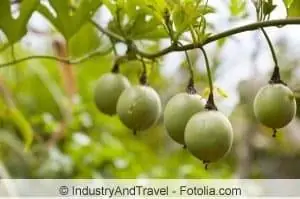
Passion fruit Passiflora edulis forma edulis, purple passion fruit, is self-fertile and produces purple fruits
- Passiflora edulis forma flavicarpa, yellow passion fruit, requires cross-pollination, bears yellow fruits, tolerates cold slightly better than the second passion fruit form, but is less cold-tolerant than P. caerula
- Passiflora incarnata, North American passionflower, frost-tolerant down to -15 °C, climbing plant up to 10 m high, old medicinal plant for insomnia, cramps and restlessness
- Passiflora ligularis, Sweet Granadilla, edible fruits, easy to grow, heart-shaped leaves are not said to be as decorative as those of the other species (matter of opinion: tropical.theferns.info/plantimages/82e879c480678f2a56ee69092c27c2eaec150e1d.jpg)
- Passiflora lindeniana, passionflower from Venezuela growing as a small tree
- Passiflora lutea, North American passionflower, frost-tolerant up to -15 °C
- Passiflora macrophylla, passionflower that grows as a tree with leaves up to one meter long, comes from Ecuador
- Passiflora murucuja, red-flowering passionflower, small and easy to care for, houseplant or summer decoration for the garden
- Passiflora x piresii, red passionflower with large flowers, sterile hybrid
- Passiflora quadrangularis, giant granadilla from the West Indies, produces the largest edible fruits
- Passiflora racemosa, red-flowering passionflower from Brazil, popular houseplant
- Passiflora tucumanensis, passion flower from the Tucumán province in Argentina, frost resistance is stated to be up to -15 °C
- Passiflora × violacea, passion flower (Passiflora) 'Violacea', a hybrid of P. caerulea and P. racemosa, well-known and popular potted plant
- Passiflora vitifolia, red-flowering passionflower Vine-leaved passionflower, smells, climbs and blooms fire-red, houseplant from Costa Rica, Nicaragua, Panama
If that's not enough for you: In the 20th century, several hundred hybrid varieties were bred from all of these Passiflora, which can at least be obtained as seeds over the Internet.
Conclusion
Passion fruit not only tastes good, but is also one of the not exactly numerous plants that can be kept quite easily in German living spaces. It could be a bit tight just with the amount of light, but with a plant light over the passiflora you can even harvest fruit

